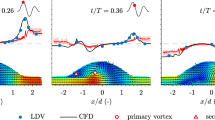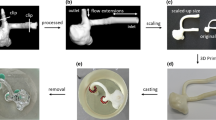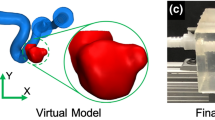Abstract
The present work presents an experimental in vitro three-dimensional analysis of the flow dynamics in an abdominal aortic aneurysm (AAA) through stereoscopic particle image velocimetry (SPIV) measurements. The experimental set-up mimics the pathophysiological context involving a shear thinning blood analogue fluid, compliant AAA and aorto-iliac bifurcation walls and controlled inlet and outlet flow rate and pressure waveforms as well as working fluid temperature. SPIV was carefully calibrated and conducted to assess the three velocity components in the AAA volume. For the first time in the literature, the 3D vortex ring genesis, propagation, and vanishing in the AAA bulge are experimentally described and quantified. In comparison with classical 2-component PIV measurements (2C PIV), the third component of the velocity vector was shown to be of importance in such a geometry, especially, during the deceleration phase of the flow rate. The 3D velocity magnitude reached up more than 20 % of the 2D one showing that 2C PIV are definitively not accurate enough to provide a complete description of flow behaviour in an AAA. In addition to potential clinical implications of a full 3D vortex ring description in AAA evolution, the 3D in vitro experimental quantification of the flow dynamics carried out in the present study offers an interesting tool for the validation of fluid–structure interaction numerical studies dealing with AAA.







Similar content being viewed by others
References
Arzani A, Shadden SC (2012) Characterization of the transport topology in patient-specific abdominal aortic aneurysm models. Phys Fluids 24(8):1901
Biasetti J, Hussain F, Gasser TC (2011) Blood flow and coherent vortices in the normal and aneurysmatic aortas: a fluid dynamics approach to intra-luminal thrombus formation. J Royal Soc Interf 8:1449–1461
Berthe A, Kondermann D, Christensen Goubergrits C, Garbe C, Affeld K, Kertzscher U (2010) Three-dimensional, three-component wall-PIV. Exp Fluids 48:983997
Bjorkquist DC (2002) Stereoscopic PIV calibration verification. In: 11th International Symposium on Applications of laser techniques to fluid mechanics, Lisbon, July
Bouremel Y, Yianneskis M, Ducci A (2009) On the utilisation of vorticity and strain dynamics for improved analysis of stirred processes. Chem Eng Res Design 87:377385
Büsen M, Kaufmann TS, Neidlin M, Steinseifer U, Sonntag SJ (2015) In vitro flow investigations in the aortic arch during cardio pulmonary bypass with stereo-PIV. J Biomech 48(10):2005–2011
Chakraborty P, Balachandar S, Adrian RJ (2005) On the relationships between local vortex identification schemes. J. Fluid Mech. 535:189214
Chen CY, Anton R, Hung MY, Meno P, Finol EA, Pekkan K (2014) Effects of intraluminal thrombus on patient specific abdominal aortic aneurysm hemodynamics via stereoscopic particule image velocity and computational fluid dynamics modeling. J Biomech Eng 136:031001-1
Cyron CJ, Wilson JS, Humphrey JD (2014) Mechanobiological stability: a new paradigm to understand the enlargement of aneurysms? J R Soc Interf 11:20140680
Davidson PA (2004) Turbulence an introduction for scientist and engineers. Oxford University Press, Oxford
Deplano V, Knapp Y, Bailly L, Bertrand E (2014) Flow of blood analogue fluid in a compliant abdominal aortic aneurysm model: experimental modelling. J Biomech 47(6):1262–1269
Deplano V, Meyer C, Guivier C, Bertrand E (2013) New Insights into the understanding of flow dynamics in an in vitro model of abdominal aortic aneurysms. Med Eng Phys 35:800–809
Gallo D, Gülan U, DiStefano A, Ponzini R, Lüthi B, Holzner M, Morbiducci U (2014) Analysis of thoracic aorta hemodynamics using 3D particle tracking velocimetry and computational fluid dynamics. J Biomech 47:3149–3155
Haller G (2001) Distinguished material surfaces and coherent structures in three-dimensional fluid flows. Phys D 149:248277
Kontopodis N, Pantidis D, Dedes A, Daskalakis N, Ioannou CV (2016) The not so solid 5.5 cm threshold for abdominal aortic aneurysm repair: facts, misinterpretations, and future directions. Front Surg 3:1
Le TB, Troolin DR, Amatya D, Longmire EK, Sotiropoulos F (2013) Vortex phenomena in sidewall aneurysm hemodynamics: experiment and numerical simulation. Annals Biomed Eng 41(10):21572170
Meyer C, Bertrand E, Boiron O, Deplano V (2011) Stereoscopically observed deformations of a compliant abdominal aortic aneurysm model. J Biomech Eng Trans ASME 133(11):111004
Olufsen MT, Peskin CS, Kim WY, Pedersen EM, Nadim A, Larsen J (2000) Numerical simulation and experimental validation of blood flow in arteries with structured-tree outflow conditions. Annals Biomed Eng 28:1281–1299
Poelma C, Watton PN, Ventikos Y (2015) Transitional flow in aneurysms and the computation of haemodynamic parameters. J R Soc Interf 12:20141394
Raffel M, Willert C, Kompenhans J (1998) Particle image velocimetry. Springer-Verlag, Berlin
Soodt T, Pott D, Schröder W (2013) Analysis of basic flow regimes in a human airway model by stereo-scanning PIV. Exp Fluids 54:15–62
Spence CJT, Buchmann NA, Jermy MC, Moore SM (2011) Stereoscopic PIV measurements of flow in the nasal cavity with high flow therapy. Exp Fluids 50:10051017
Stamatopoulos Ch, Mathioulakis DS, Papaharilaou Y, Katsamouris A (2011) Experimental unsteady flow study in a patient-specific abdominal aortic aneurysm model. Exp Fluids 50:1695–1709
Tritton DJ (1988) Physical fluid dynamics, 2nd edn. Clarendon Press, Oxford
von Spiczak J, Crelier G, Giese D, Kozerke S, Maintz D, Bunck AC (2015) Quantitative analysis of vortical blood flow in the thoracic aorta using 4D phase contrast MRI. PLoS ONE 10(9):e0139025
Xenos M, Labropoulos N, Rambhia S, Alemu Y, Einav S, Tassiopoulos A, Sakalihasan N, Bluestein D (2015) Progression of abdominal aortic aneurysm towards rupture: refining clinical risk assessment using a fully coupled fluid structure interaction method. Annals Biomed Eng 43(1):139–153
Yagi T, Sato A, Shinke M, Takahashi S, Tobe Y, Takao H, Murayama Y, Umezu M (2013) Experimental insights into flow impingement in cerebral aneurysm by stereoscopic particle image velocimetry: transition from a laminar regime. J R Soc Interf 10:20121031
Zhou J, Adrian RJ, Balachandar S, Kendall TM (1999) Mechanisms for generating coherent packets of hairpin vortices in channel flow. J Fluids Mech 387:353–396
Acknowledgments
The authors thank the Labex MEC ANR-11-LABX-0092 for financial support.
Author information
Authors and Affiliations
Corresponding author
Electronic supplementary material
Below is the link to the electronic supplementary material.
Rights and permissions
About this article
Cite this article
Deplano, V., Guivier-Curien, C. & Bertrand, E. 3D analysis of vortical structures in an abdominal aortic aneurysm by stereoscopic PIV. Exp Fluids 57, 167 (2016). https://doi.org/10.1007/s00348-016-2263-0
Received:
Revised:
Accepted:
Published:
DOI: https://doi.org/10.1007/s00348-016-2263-0




